You Don't Know College Football's Most Intimate Rivalry
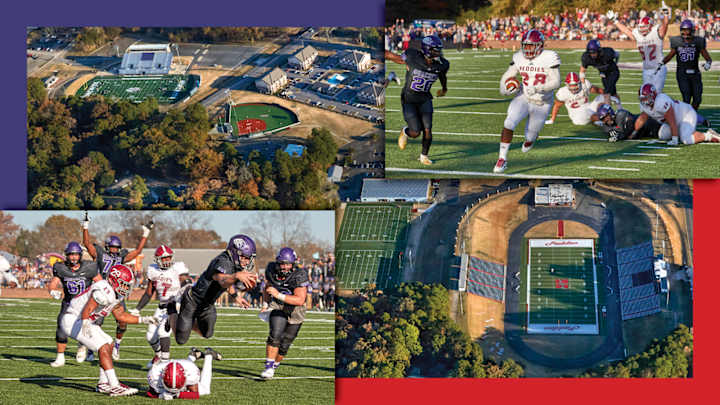

Past tailgaters saluting with Solo cups from atop pickup-truck beds, the Henderson State Reddies march. Past family members reaching for fist bumps and alumni clanging cowbells and cheerleaders ruffling pompoms. Past trilling piccolos and tooting tubas and the upright feather plumes of the Showband of Arkansas. Past a massive sign hanging from a student apartment, underneath a cloudless Saturday afternoon sky: OUACHITA PLAYS MADDEN ON ROOKIE MODE.
Two weeks until Thanksgiving, this is rivalry season in the college football world. But for all of the Civil Wars and Big Games waged, for every Old Oaken Bucket and Holy Bronzed Oil Filter Wrench up for grabs, there is no annual tradition quite like the Division II Battle of the Ravine.
Hefting shoulder pads and helmets, cleats click-clacking on pavement, Henderson’s players set out on foot from their fieldhouse, an hour southwest of Little Rock, in Arkadelphia, and walk straight to their regular-season finale, against Ouachita (WASH-i-taw) Baptist, which is located directly across an undivided highway. All told, this road trip takes less than 10 minutes—past state troopers halting traffic, through a lot of unfriendly Tigers fans, right into the visiting locker room.
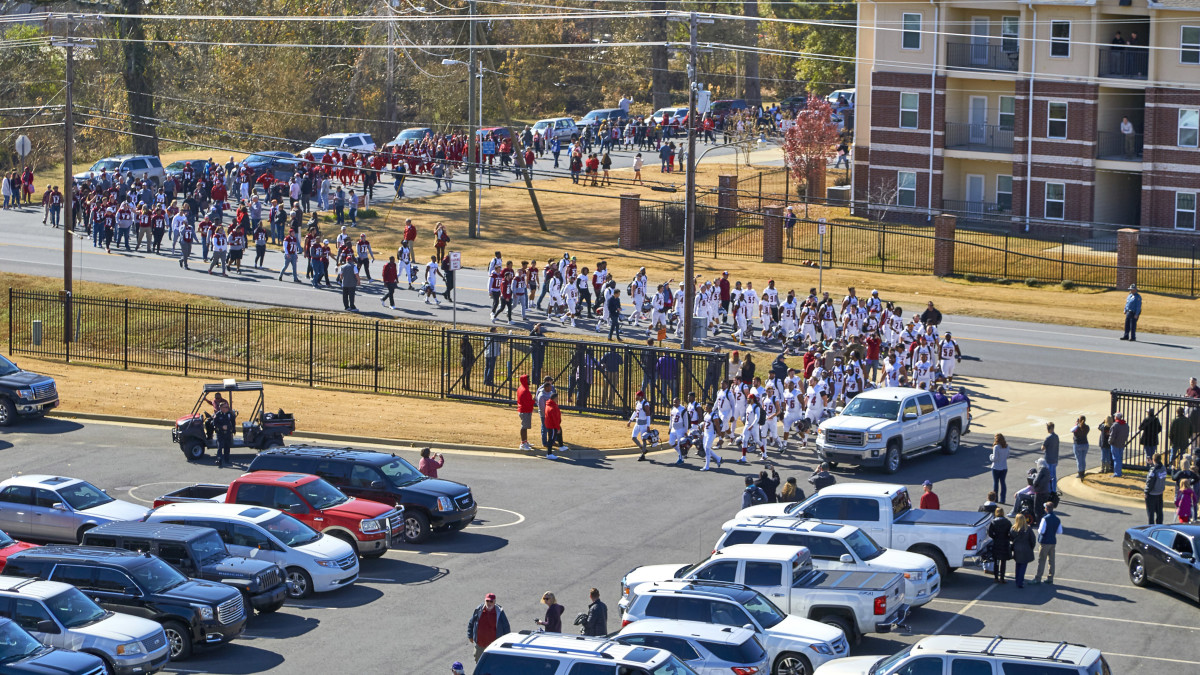
Alabama will drive more than 150 miles to square off with Auburn in the Iron Bowl this weekend. By comparison, a Henderson golf coach once teed off from the south end zone of the Reddies’ football stadium and reached the bowl at Ouachita’s field with a mid-iron on his second shot.
This hyperlocal series has been going steady since Teddy Roosevelt’s second term, but the stakes have rarely been higher than in this 93rd edition. Ranked No. 20 in the national coaches poll, the Reddies (9–1) can all but clinch their first D-II playoff bid since 2015. To do so they need only upend the unbeaten, No. 5 Tigers, who are eyeing a third consecutive Great American Conference championship—and, perhaps more important, a fourth straight win against an opponent with whom their all-time record is tied at 43-43-6, with nearly half those games determined by seven or fewer points.
But as any Arkadelphian will testify, from the stools of the town’s three bars or the pews of its nearly three dozen churches, the Battle of the Ravine—by some measures the oldest D-II football rivalry—transcends any single year’s result. It is about the differences between the institutions: public, secular Henderson (Heathen State, to some) versus private, religious Ouachita. Small (HSU: 3,594 students) versus even smaller (OBU: 1,633). Stereotypically fratty versus stereotypically snooty. “The rivalry is bigger than yourself,” says ex-NFL tight end Sean McGrath (Henderson, class of 2012). “So, regardless of how nice they were, if a [Ouachita] kid had freckles, you hated him and you hated the freckles on his face because he went to OBU.”
It’s about a history speckled with familiar football faces. Auburn coach Gus Malzahn faced the Tigers twice as a Reddies receiver, including in a 3–3 tie in 1988 that ended early due to flooding; Ouachita’s stadium is named after Cliff Harris (class of ’70), a two-time Super Bowl–champ with the Cowboys. It’s about a passion brewed from thrilling comebacks, controversial finishes and legendary pranks, all the ingredients of the tastiest college feuds. It’s about stories that divide households and bind generations. “If you grow up in Arkansas,” says Malzahn, “you know about the Battle of the Ravine.”
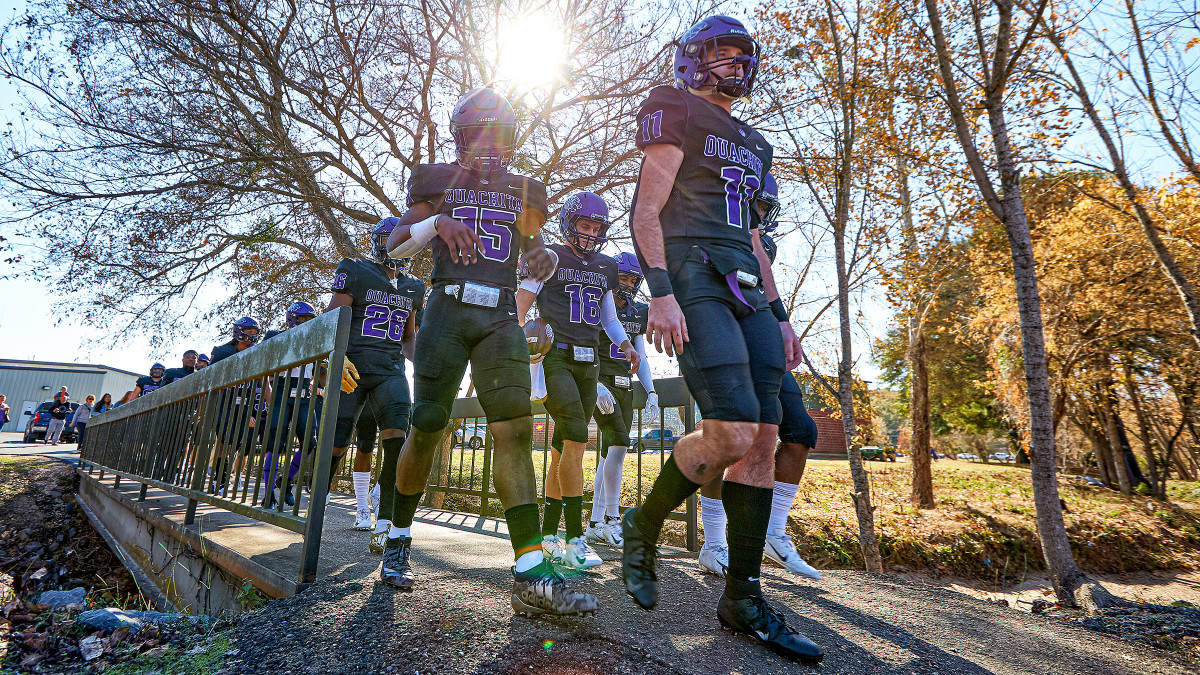
That nickname comes from the kudzu-laced crevasse that cuts through both Henderson, on the west side of Route 67, and Ouachita, on the east. Above all else, this proximity is what makes the game so special: Nowhere else in the country is rivalry so neatly, nastily condensed as it is in Arkadelphia. Students from the neighboring schools take classes together, act in plays together, pledge social clubs together. Reddies park at their own risk outside Newberry Hall, a Henderson dorm plopped on Ouachita’s side of the street; such are the odds that they’ll wind up with shoe polish/glitter/maple syrup/bologna/Cheese Whiz slathered across their windshields.
“We live this 365 days of the year,” says Ouachita’s 62-year-old athletic director, David Sharp. “That’s the difference between us and other rivalries. They go back to their own entities. I go to lunch, and there’s [Henderson State’s] AD. I go to dinner, and there’s their football coach.”
* * *
Rewind three days and you’d have to forgive an arriving Arkadelphia visitor for fearing that both schools had been placed under quarantine. All along the highway that separates the campuses, virtually every piece of university-related signage, plus the scoreboard at Ouachita’s stadium and a fountain outside Henderson State, is wrapped in polyethylene plastic and duct tape, to safeguard against shenanigans—a telltale indication that rivalry week has arrived. “And the students will still try to paint them,” says Sharp.
More than maybe anyone else around, Sharp understands what the Battle of the Ravine means in this map-dot city of 10,000-odd full-time residents. His parents met when they were students at Ouachita; father Ike famously led a 14-point comeback over Henderson in 1949 with three successful onside kicks in the final seven minutes. David’s brother, sister and two nephews attended Ouachita too. Ditto for his daughter and his son. Personally he has been invested in the game for more than four decades now: five years as a player, 19 on the coaching staff, 20 more and counting as athletic director. But while he bled Ouachita purple from birth, Sharp never quite tasted the true passion until he enrolled as a freshman lineman in ’75.
“This us-and-them, Hatfields-and-McCoys mentality . . . ” he says. “I would walk out of my residence hall and I’m 125 yards away from a Henderson dorm. The whole week—going to class, pregame meal—their students are hollering at us out their windows, ‘OBU sucks!’ ”
Really, though, Sharp wasn’t experiencing anything new. The schools first met for an unsanctioned football game in 1885, but their respective presidents, fearing that an official crosstown match would “engender bitterness,” held off on a real meeting until 1907. Then it was on. After Henderson won the first six games and tied the seventh, emboldened Reddies fans boasted at a ’15 pep rally that Ouachita would only triumph over their “dead bodies.” When the Tigers indeed pulled off the upset 34–7, their fans dressed up a dummy in a crimson Reddies uniform and lowered it into an on-campus grave, where a minister read last rites.
Fervor has naturally fluctuated along with the teams’ collective competitiveness over the decades, but it never fully fades. In the 1980s, recalls former Henderson sports information director Mike Dugan, longtime football coach Ralph (Sporty) Carpenter would cruise around Ouachita’s campus in his gray pickup truck, Reddies script painted on both of his front doors, honking at the enemy. “He’d go, ‘Look at all the Baptist kids flipping us the bird!’ ” Dugan says. “He got the biggest kick out of that. Gosh, he hated Ouachita.”
Of course such sustained animus can inspire truly unsportsmanlike behavior. One afternoon in 1999, Sharp’s first year as Ouachita’s AD, the team discovered a video camera, still bearing a PROPERTY OF HENDERSON STATE ATHLETICS label, recording a Tigers practice from atop a trash can. Sharp kept the tape, returned the camera and, once word of the small-town Spygate spread, printed up T-shirts jabbing at the believed cheaters. “They sold like hotcakes,” he says.
Indeed, it takes a certain sense of humor to survive the rivalry. Anything else would render life untenable for the other 51 weeks in Arkadelphia. Which is why even purple-blooded Tigers like Sharp can appreciate that morning in November 1978 when sugary red-and-gray confections rained down from the sky.
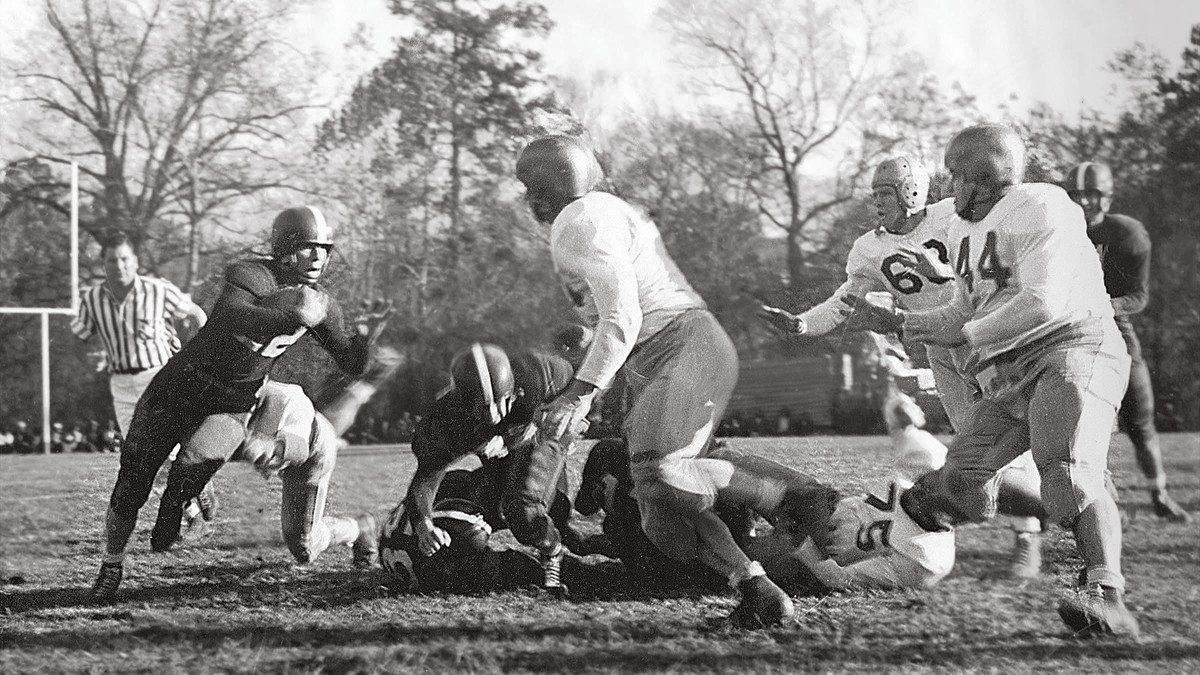
* * *
A thousand-odd feet above the soybean fields and timber forests outside Arkadelphia, a pilot banks to the west and peers down at the Ouachita campus below. “All along here is the drop route,” he says. “But there was no aim involved. Basically, let the wind do it. If one marshmallow landed, it was a big accomplishment.”
Because he still flies for a living, the pilot in question requested anonymity before agreeing to retrace his famous flight, given the numerous FAA regulations he and five fellow Henderson aviation students potentially violated four decades ago, on the eve of the 57th Battle of the Ravine. So let us simply call him CJP, for Captain Jet-Puffed.
CJP was a Henderson State junior in his early 20s when he and another prankster, each in Cessna 172s, departed from nearby Hot Springs, Ark., around 10:50 a.m. The two pilots headed south at the lowest legal altitude to avoid radar detection, each plane loaded with garbage bags full of mallows painted in Reddies colors. Then they emptied their caches over Ouachita one minute apart before flying off, never to be discovered.
“A lot ended up in the ravine,” CJP says. “But, hey, it was a cool college prank for the time.”
CJP was inspired by a classmate who’d pulled off a similar drop three years earlier. But, really, he was just the next in a long line of pranksters (some of their stories hyperbolized, no doubt) who’ve been as integral to Battle of the Ravine as the players themselves. The most well-worn tale dates back to 1950, when Ouachita’s homecoming queen, Ann Strickland, was snatched by some Henderson students—former high schoolmates with whom she was friendly—and, essentially, held hostage at a nearby lake house. Several days passed before Strickland was safely returned, though not before her boyfriend and future husband, a Tigers defensive end named Bill Vining Sr., led teammates on a citywide manhunt. (Among the searchers: Ike Sharp, who busted into rooms at a nearby hotel with a shotgun stuffed inside his overalls.)
Or there was the night in 1973 when a Ouachita freshman named Mike Huckabee—yes, that Mike Huckabee—masterminded a scheme to set Henderson’s pep-rally bonfire ablaze ahead of schedule. Says Huckabee of the prank, which was designed to be pulled off with a flaming arrow but was executed manually when that failed: “I may have been a material witness, but I think the statute of limitations has run out.”
Locals will tell you the record books are tossed out the window when the Tigers and the Reddies meet—but so are eggs, water balloons, glitter bombs and so on. Before this year’s game four Henderson students snuck into Ouachita’s basketball gym and caked the backboards with Silly String. 'For Sale' signs sprung up across Henderson’s campus, a jab at financial woes that led to the school’s merging recently into the Arkansas State system. Bags of dog feces—or what was presumed to be dog feces—littered the Reddies’ football field; at Ouachita’s stadium the lights were kept on all night, all week.
There is a line, of course. And it has been crossed by both sides. The rivalry was outright suspended between 1952 and ’62, partly due to excessive vandalism. As recently as 2015 seven students were arrested for slashing tires, pouring sugar into gas tanks and spray-painting cars. This year’s damage, according to police, resulted in school and local officials issuing a total of 20 ticketed citations across both campuses.
Those cops might be fighting an uphill battle in the ravine, but here they have help. At Henderson band members pull overnight shifts protecting oft-targeted campus monuments, including the aforementioned fountain and an old bell that was saved from the wreckage of a campus fire in 1914.
Over at Ouachita, meanwhile, the brothers of the Rho Sigma social club have for decades focused their defense efforts on the school’s marble tiger statue. That poor mascot has endured plenty of abuse over time—in 1978 alone it was coated in red paint, tar, Christmas tinsel and gasoline before being lit afire—leading in 2010 to the installation of an iron protective fence and security cameras.
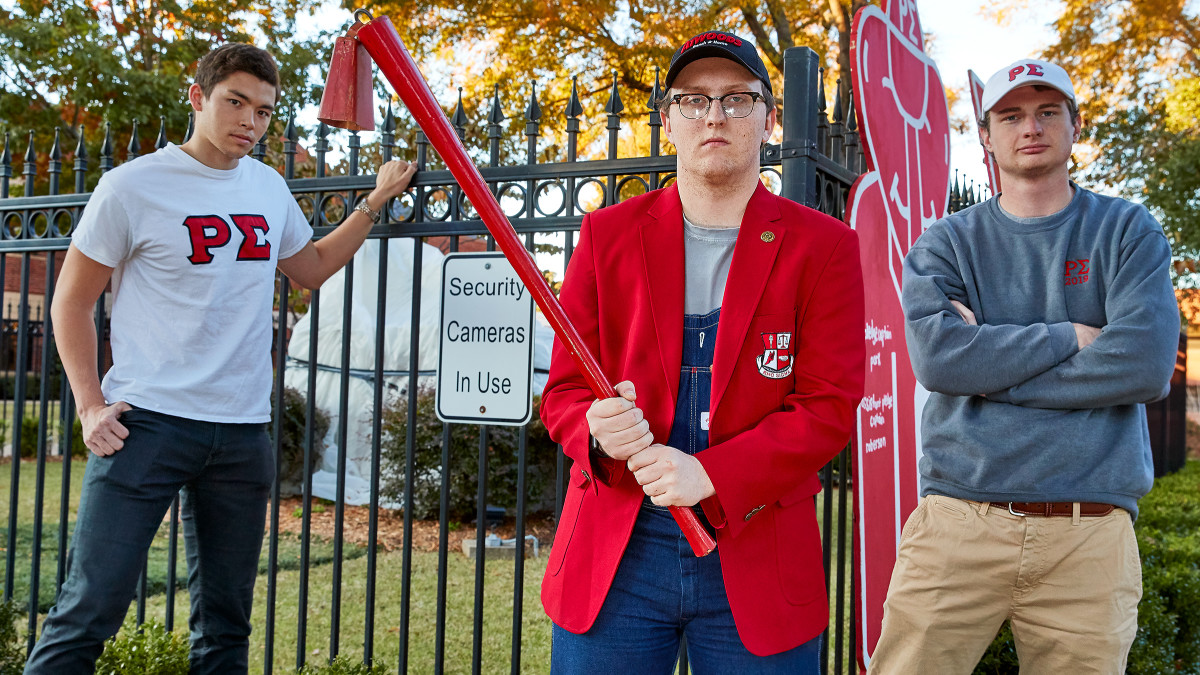
Which hasn’t entirely put the Rho Sigmas at ease. Ducking into a tent outside the statue two days before this year’s game, president Luke Roberson fetches a red metal rod with a cowbell attached to the end. At one time the instrument was used by pledge masters to haze new members, but its purpose has evolved. “Now we call it our Reddie stick,” Roberson says—perfect for chasing away anyone who wanders too far across the road.
* * *
How did we get here? How did two D-II universities with such rich football traditions—since it was established in 2011, the now 12-team Great American Conference has handed its title to a school outside Arkadelphia just once—end up so close that their stadium press boxes are within eyeshot of one another? Appropriately enough, the story starts with a rivalry.
Named for the river whose shores run along the campus’s eastern edge, Ouachita Baptist College first convened classes in September 1886, part of a larger effort by religious groups to establish institutions of higher education across Arkansas. Not to be outdone, according to author Bennie Gene Bledsoe’s history of Henderson, local Methodists followed suit four years later and founded Arkadelphia Methodist College, choosing a “high and beautiful site . . . about the highest point in the city.” Higher, even, than their new neighbors’. (AMC, then known as Henderson-Brown, became a state teachers college in 1929, but its religious roots aren’t forgotten. The Reddies’ fight song is set to the tune of “Gimme that Old Time Religion.”)
As for the town itself, the windswept bluff on the western side of the Ouachita River was settled around the turn of the 19th century as Blakelytown, after a local blacksmith believed to have overseen construction of the area’s first building. Decades passed before the name Arkadelphia was adopted, but its meaning—“arc of brothers,” basically—remains fitting. After all, the Battle of the Ravine is filled with family members facing off from opposing sides.
Like Bobby Jones. As a teenager in 1967 Jones was set to walk on for the Tigers—right up until the Reddies swooped in with a last-minute scholarship offer. He went 2–2 against Ouachita and drove the getaway car when some teammates broke off the tiger statue’s marble tail and buried it along a Route 67, where it presumably remains today. Jones would go on to serve as Henderson’s CFO, interim president and interim athletic director. But both of his sons went to Ouachita. And his wife, Judy, a former Henderson cheerleader, crossed sides herself to take a job as OBU’s registrar. “We’re a house divided for one day a year,” says Jones, now 70 and retired.
Cliff Harris, the Tigers legend? He followed in the footsteps of his own father, who suited up for two seasons at Ouachita—though not without some thought. His mother and grandmother had gone to Henderson. Then there’s Morgan Bowles, an athletic trainer with this year’s Reddies. She’s married to Ouachita’s own head trainer, Kyle Bowles. To keep things light, their labrador, Riggs, wears a collar each November in the colors of that year’s Battle of the Ravine winner. Still, says Kyle, “It’s intense. We won’t even see each other during the week.”
Players tend to hole up, to stay out of trouble during the Battle buildup, but they aren’t immune from the crosstown buzz. They sit in classes with students from the other side as part of the schools’ joint educational consortium, and they commingle in Greek life. In 2008, Ouachita receiver Julius Pruitt endured plenty of smack talk from his brothers at the Henderson chapter of Phi Beta Sigma, which he pledged because Ouachita has no fraternities. But he got the last word when he caught four touchdowns in a 43–36 Tigers win. Consider, too, the Bible study group hosted for the past six years by Wesley Kluck. Each Sunday the Ouachita administrator welcomes a mix of football players: half of them Tigers, half Reddies.
How does that work? “The game means so much, but there’s a civility,” says Henderson athletic director Shawn Jones. “We live in the same town, so you kind of have to. Other rivalries, it’s real easy to talk trash all year long when you live 100 miles [apart]. But when it’s your next door neighbor? We all have to live together and work together and worship together.”
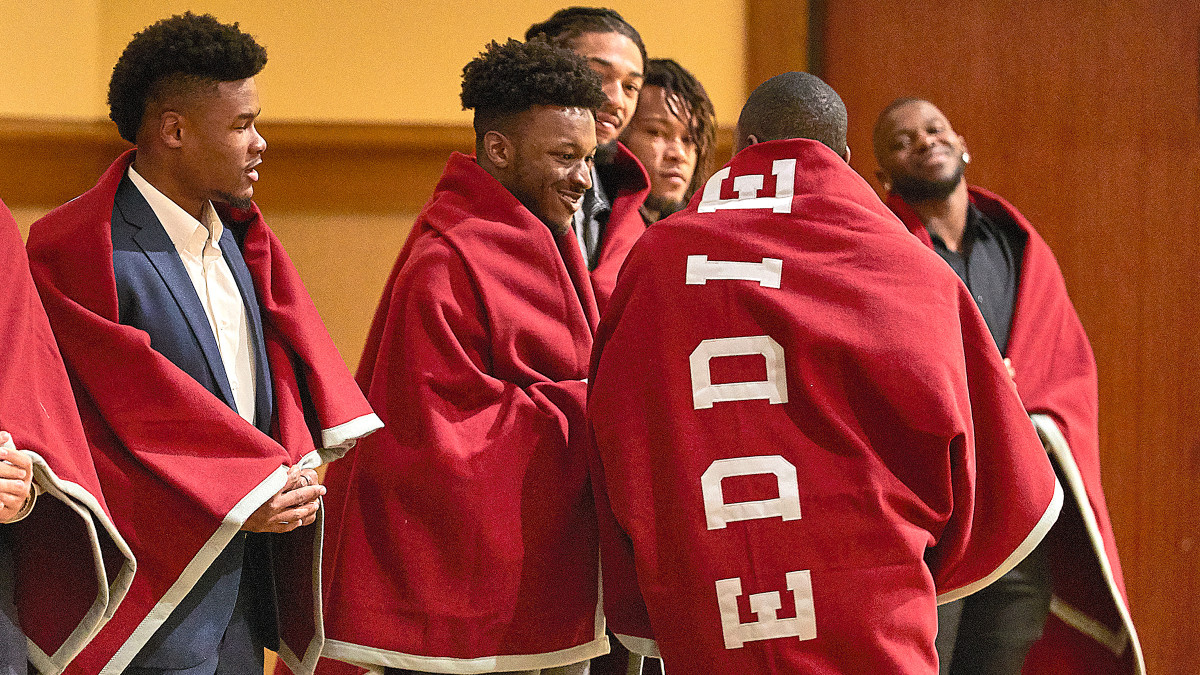
That sentiment only extends so far. On the eve of this year’s game, Henderson’s players gather in a ballroom for a steak dinner and a century-old tradition in which Reddies seniors are gifted with ceremonial crimson blankets. Afterward, 22-year-old Clifford Jackson III weighs whether he would ever visit Ouachita’s campus on rivalry week.
“No, no, no, no, no,” the 6' 5", 297-pound left tackle chuckles, wearing his blanket like a boxer’s robe. “It’s nothing but business. And everything is personal.”
* * *
On this picture-perfect Saturday afternoon, the 93rd Battle of the Ravine is underway.”
From his perch in the press box at Cliff Harris Stadium, the radio voice of the Tigers can see it all. The opening kickoff, tumbling through the air. The stands and berms packed with an announced crowd of 8,891—more than 2,000 beyond capacity. The scoreboard, finally unsheathed from its tarp. The Henderson press box, looming on a hill across the highway. And, not far in the other direction, the property where he grew up.
This marks Rex Nelson’s 37th year calling Ouachita’s play-by-play, a job he started as a freshman, back in 1978. Like most everyone else in Arkadelphia, though, he was indoctrinated long before he matriculated, working as a water boy at Tigers practices and listening to stories from his father, a former player.
As such Nelson has developed an encyclopedic knowledge of Henderson-Ouachita history. To him, three installments of the series stand out above the rest. In 1975 there was the Drive, led by Tigers quarterback Bill Vining Jr. (son of the kidnapped homecoming queen, Ann Strickland), culminating in a 4th-and-25 completion and a 21–20 victory that ruined the Reddies’ perfect season. And Henderson’s controversial, game-ending goal line stand against Ouachita in 2011. (Did the Tigers cross the goal line? Didn’t they? “You can get a debate going very easily, just on that,” Nelson says.) Finally, there’s the triple-overtime marathon of ’13, when hundreds of nonattending locals raced to Ouachita’s stadium at the end of regulation, parked along the shoulder of the highway and watched Henderson clinch the conference title 60–52 from the roofs of their cars. “We tried to stay classy on the air,” Nelson says, “but it was absolutely awful.”
A bumpy season for Henderson made the 2018 game a rare snoozer—38–10, Ouachita—but as the Tigers chip away at a 14–0 first-quarter deficit and then take a 17–14 lead, the 2019 meeting turns into an instant classic. Henderson forces a fumble and scores with 1:44 left, going up 21–17. But the ensuing seven-play, 74-yard Ouachita drive climaxes with running back Brockton Brown plunging into the end zone from the one—the same spot, on the same side of the stadium, where the Tigers were stopped eight years ago. Final: 24–21, Ouachita.
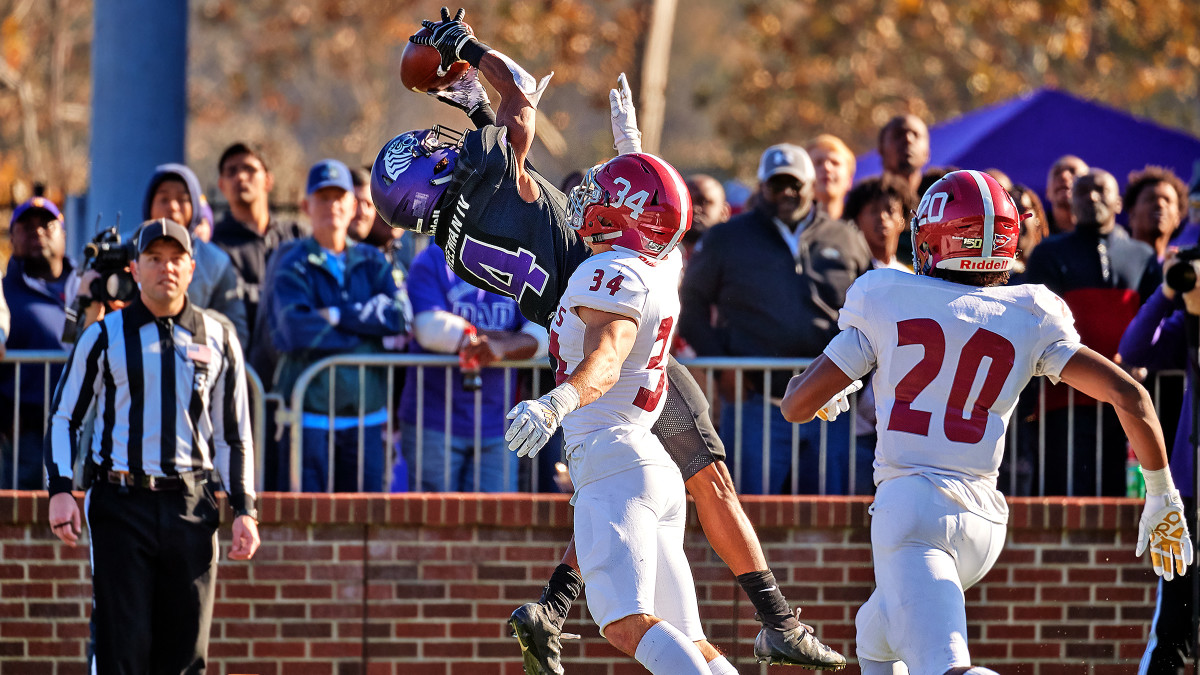
“I have a few high school friends on the other side,” says Brown, who grew up less than an hour away, in Sheridan. “Now I get to give them crap for 364 days.”
As the Reddies begin their walk back home, across the highway, Ouachita students spill from the stands to join a raging celebration at midfield. In the center Sharp lifts up the Battle’s spoils: a partially deflated old football, painted in the two schools’ collective colors, that has been awarded to the winner of each game since 1970. Everyone roars.
“I was worried that I was going to be really distraught the next morning at church,” Sharp later admits. “But now everything is going to be all right.”
* * *
Well, let me go ahead and state the obvious,” Pastor Louie Heard begins his sermon. “Another Battle of the Ravine is in the books.”
As the protective tarps are lowered across both campuses, so are the guards of those in the community, hundreds of whom have gathered at Arkadelphia’s Second Baptist Church for Sunday-morning services. Henderson and Ouachita students share the balcony seats. Down below, worshipping Reddies include their men’s basketball coach, their swim coach and a former university president. The Tigers’ current O-line coach passes around a collection plate.
“Both purple and red, in one room,” Heard tells a crowd of hundreds. “That’s a good thing.”
Take, for example, the Parris family. Seated in the next-to-last pew on this particular morning are Kyle, who attended Ouachita in the late 1980s and later worked for five years in the school’s athletics department; and his father, Stan, who starred at free safety for Henderson in the ’60s and still holds the school’s career interceptions record. Later Stan became a pastor at Second Baptist, where he would preach while sipping from a Reddies water bottle and refer to Ouachita only as “that school across the street.” Father and son haven’t seen each other since Monday, when they bet the first slice of peppermint cake at Christmas on the outcome of the game.
But now, “after all the pranks, all the back and forth,” Kyle says, “everyone comes together again. It’s just happier for one side than it is for the other.”
